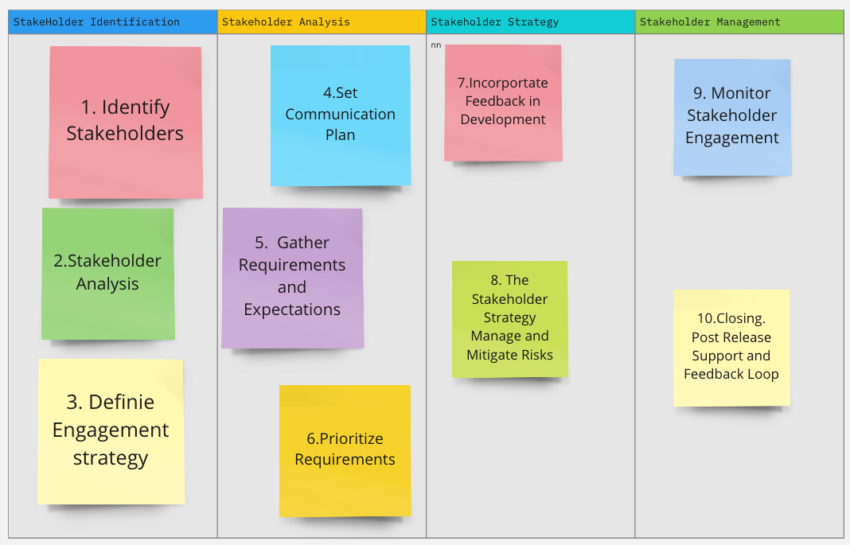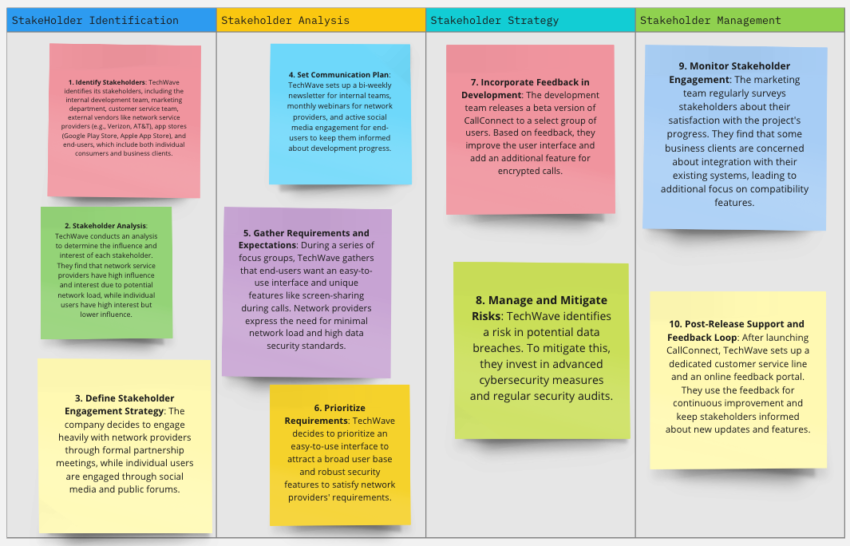Stakeholder Management – The Maestro of Stakeholder Symphony: Orchestrating Business Interests Into a Harmonious Opus
What is stakeholder management and why would I care?
Imagine you’re building a super cool fort and want it to be the best. Stakeholder management ensures everyone who cares about your fort, like your friends, family, and even your grumpy neighbor, is happy. You talk to them, understand what they like or don’t like, and then decide how to make your fort awesome while keeping everyone smiling.
It’s important because if they’re happy, they might give you more pillows for the fort, help you build it, or even bring snacks! Plus, no one will be mad or try to take it down. So, it’s like being a fort boss who makes everyone feel important and heard. Let’s describe it more academically.
Stakeholder management is the strategic process of identifying, understanding, and effectively engaging with individuals or groups interested in, or are impacted by, a project or a company’s operations. It involves analyzing stakeholders’ needs and expectations, prioritizing their concerns, and continuously communicating with them to build strong, mutually beneficial relationships.
The goal is to ensure that stakeholders are informed con, consulted, and actively involved in decision-making processes where appropriate. This approach helps achieve project objectives, mitigate risks, and foster a collaborative environment for success.
Stakeholder Management Process

Stakeholder Management Theory by Mark V. Smetanin
- Identify Stakeholders: Start by identifying all potential stakeholders. This includes internal teams (e.g., development, marketing, sales), external partners (e.g., software vendors, network service providers), and end-users (both individuals and businesses).
- Stakeholder Analysis: Assess each stakeholder’s influence, interest, and impact on the project. This step is crucial to understand who needs more attention and how they can affect the project’s success.
- Define Stakeholder Engagement Strategy: Based on the analysis, develop a strategy for engaging with stakeholders. This could range from regular updates to involving them in critical decisions.
- Set Communication Plan: Establish a clear communication plan. Decide on the frequency, channels (emails, meetings, newsletters), and communication content for each stakeholder group.
- Gather Requirements and Expectations: Collect detailed requirements and expectations from key stakeholders. This might include features, security standards, and user interface preferences for a phone call application.
- Prioritize Requirements: Not all stakeholder requirements can be met due to time, budget, or technology constraints. Prioritize these requirements based on their impact on the project’s success and stakeholder importance.
- Incorporate Feedback in Development: As the development progresses, continuously incorporate stakeholder feedback. This could involve beta testing with a select group of users or regular review meetings with internal teams.
- Manage and Mitigate Risks: Identify potential risks that might affect stakeholder satisfaction or project success and develop strategies to mitigate these risks.
- Monitor Stakeholder Engagement: Regularly assess the effectiveness of your stakeholder management efforts. Are stakeholders engaged? Are they satisfied with the progress? Adjust your strategies as needed.
- Post-Release Support and Feedback Loop: After the application launch, engage with stakeholders. Gather feedback for future improvements and keep them informed about updates and changes.
Now, let’s imagine some real Stakeholder Management Scenarios!
Let’s imagine a scenario where a tech company, “TechWave,” is developing a new phone call application named “CallConnect.” Here’s how they might approach stakeholder management in 10 steps, using real-world examples:
- Identify Stakeholders: TechWave identifies its stakeholders, including the internal development team, marketing department, customer service team, external vendors like network service providers (e.g., Verizon, AT&T), app stores (Google Play Store, Apple App Store), and end-users, which include both individual consumers and business clients.
- Stakeholder Analysis: TechWave conducts an analysis to determine the influence and interest of each stakeholder. They find that network service providers have high influence and interest due to potential network load, while individual users have high interest but lower influence.
- Define Stakeholder Engagement Strategy: The company decides to engage heavily with network providers through formal partnership meetings, while individual users are engaged through social media and public forums.
- Set Communication Plan: TechWave sets up a bi-weekly newsletter for internal teams, monthly webinars for network providers, and active social media engagement for end-users to inform them about development progress.
- Gather Requirements and Expectations: During a series of focus groups, TechWave gathers that end-users want an easy-to-use interface and unique features like screen-sharing during calls. Network providers express the need for minimal network load and high data security standards.
- Prioritize Requirements: TechWave prioritizes an easy-to-use interface to attract a broad user base and robust security features to satisfy network providers’ requirements.
- Incorporate Feedback in Development: The development team releases a beta version of CallConnect to a select group of users. Based on feedback, they improved the user interface and added features for encrypted calls.
- Manage and Mitigate Risks: TechWave identifies a risk in potential data breaches. They invest in advanced cybersecurity measures and regular security audits to mitigate this.
- Monitor Stakeholder Engagement: The marketing team regularly surveys stakeholders’ satisfaction with the project’s progress. They find that some business clients are concerned about integration with their existing systems, leading to additional focus on compatibility features.
- Post-Release Support and Feedback Loop: After launching CallConnect, TechWave sets up a dedicated customer service line and an online feedback portal. They use the feedback for continuous improvement and keep stakeholders informed about new updates and features.

Stakeholder Management Practical Example
Stakeholder Management is Still Complex? Let’s put it and funnily!
I’ve just embarked on an exhilarating safari 🦁🌿 in the wild world of Stakeholder Management, and guess what? It’s been nothing short of an adventure! Here’s a sneak peek of my journey:
- The Stakeholder Safari 🦓: Identifying all the unique creatures in the corporate jungle, from the mighty decision-makers to the keen-eyed end-users.
- Who’s Who in the Zoo 🐒🦜: Analyzing each ‘animal’ to understand their roars and whispers in our project ecosystem.
- Engagement Party Time 🎊: Crafting bespoke engagement strategies – some prefer formal galas, others love casual coffee chats!
- Gossip Train Conductor 🚂💬: Steering the communication plan on the right track – ensuring everyone’s in the loop and entertained.
- Wish-List Genie 🧞♂️: Gathering and understanding the wishes and needs of every stakeholder – no magic lamp required!
- Building the Priority Pyramid 🛕: Strategically stacking needs and wants, balancing the art of the possible with the practical.
- The Feedback Festival 🎡: Inviting stakeholders to our beta bonanza – where their opinions are the star attractions!
- Spinning the Risk Roulette 🎰: Anticipating challenges and strategizing solutions – all in a day’s work!
- Keeping an Eye on the Engagement Meter 📈: Measuring the heartbeat of stakeholder satisfaction – always aiming for the stars!
- The Never-Ending Story 📖: Continuously evolving because the improvement journey is never over!
Updated on: . Author:
